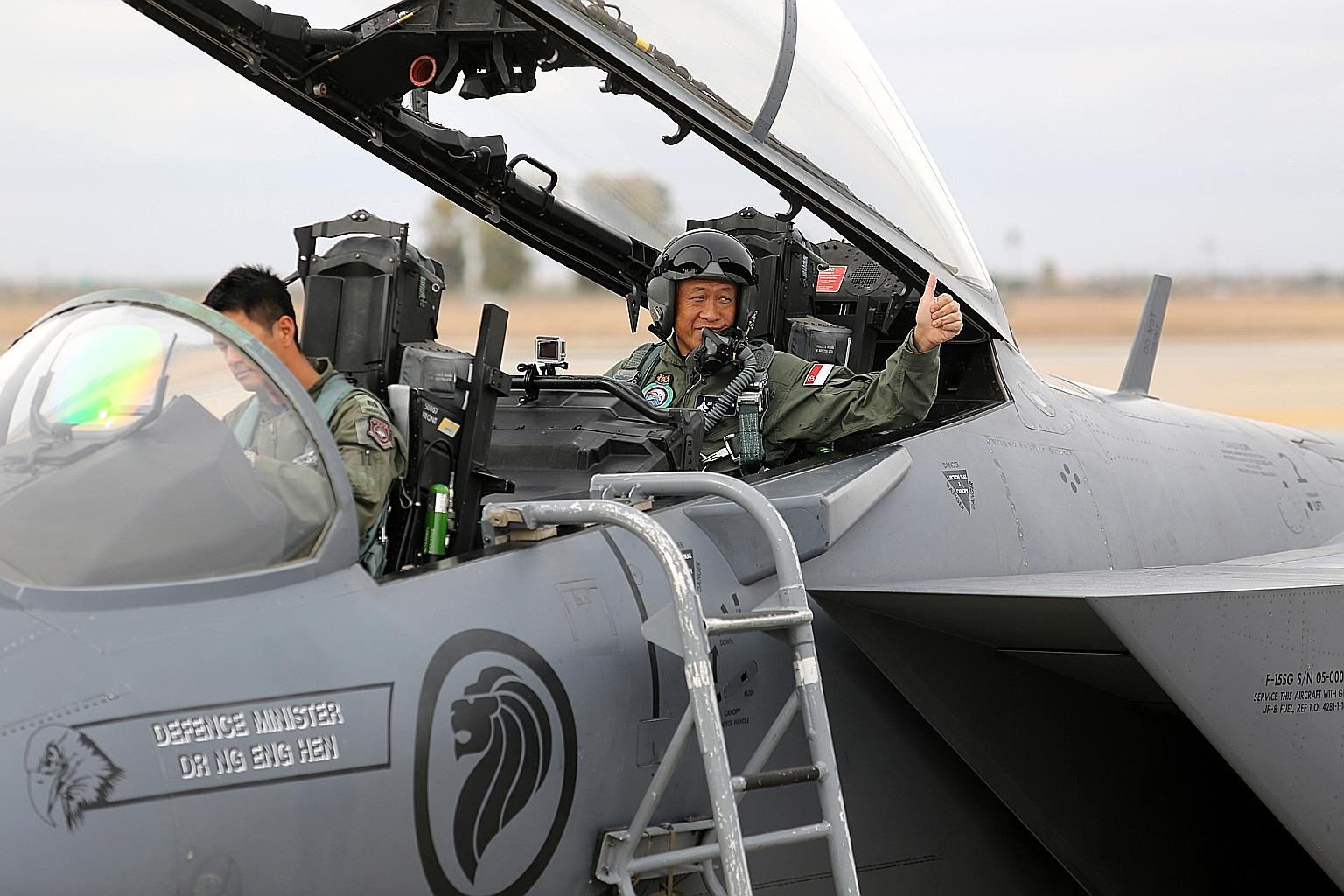Few militaries train like SAF, says Ng Eng Hen
Forging Sabre drills provide 'high tempo' and 'complex scenarios', says defence minister
Sign up now: Get ST's newsletters delivered to your inbox

Defence Minister Ng Eng Hen preparing for take-off in an F-15SG piloted by Major Shewen Goh in Arizona, US. Dr Ng was there to observe how Singapore's air and ground troops worked together.
PHOTO: LIANHE ZAOBAO
Jermyn Chow, Jermyn Chow Defence Correspondent In Luke Air Force Base (Arizona)
Follow topic:
Seated inside the F-15SG fighter jet, Defence Minister Ng Eng Hen yesterday flew over the rugged terrain of the Arizonian desert at 5,500m above ground to observe how Singapore's air and ground troops worked together to quash the enemy.
He saw how pilots from other F-15s and F-16s exchanged information seamlessly with troops and battle planners to overcome hostile fire and destroy two moving enemy rocket launchers.
The live-fire strike operation is part of the Singapore Armed Forces' (SAF) most complex unilateral exercise yet, code-named Forging Sabre.
The biennial drill held in the Barry M. Goldwater Training Area, which is 20 times the size of Singapore, is the fifth in the Forging Sabre series that started in 2005.
Back then, as Second Defence Minister, Dr Ng was perched on a rocky hill in the Mojave Desert in California to see how airmen and soldiers experimented with joint strike missions in the inaugural integrated live-firing exercise.
Yesterday's seamless coordinated attacks showed how the SAF has come a long way in the last 10 years as a third-generation (3G) fighting force, Dr Ng told reporters after his 90-minute flight.
Few militaries around the world can train like the SAF at such a "high tempo and with such complex scenarios", he noted.
"It's also because we have steady defence budget spending. We don't have ups and downs. We don't cancel programmes. Platforms that we get, we integrate. We (have) a very strong defence technology community, very strong maintenance."
Dr Ng said the drills provide troops with " the kind of robustness and resilient system to be able to, in each exercise, learn something and then to just improve on it".
In past Forging Sabre drills, men and machines were put through scenarios to tighten their communication and weapons systems network so as to sharpen and multiply their combat power to strike stationary and moving targets.
New weapons systems like the High Mobility Artillery Rocket System were also being put through their paces.
While airborne yesterday, Dr Ng saw how the SAF's latest eye in the sky, the Heron 1 unmanned aerial vehicle (UAV), successfully spotted and pinpointed, with laser beams, moving hostile targets that had to be destroyed. The UAVs, which were launched in 2012, had to hit the mark in the 17-day, live-firing drill to be declared operational next year.
It was Dr Ng's second time flying in the back seat of a fighter jet - the first time was in 2005 in an F-16.
Before his flight, Dr Ng visited the exercise troops, and mingled with the servicemen and their families who live in Phoenix, Arizona. The south-western city is where the Republic of Singapore Air Force's Peace Carvin II detachment, which operates the F-16s, is based.
During his two-day visit, which ends today, Dr Ng also got a close-up look at the United States Air Force F-35A joint strike fighter (JSF), as Singapore mulls over whether to buy the Lockheed Martin fifth-generation fighter jet. When asked, Dr Ng would say only that defence planners were still evaluating.
Noting, however, that the US Air Force is on track to declare its F-35A models operational by the second half of next year, Dr Ng said: "So the more mature the programme is, the more steady the production lines for JSF, the more boxes are ticked when we evaluate it."
But while Singapore will continue to buy the war machines it needs, Dr Ng said what will define its military might is the ability to integrate them into the fighting force to sharpen its firepower.
"Just the fine-tuning... the (war-fighting) tactics, the ability to find precise options for specific targets and specific needs, is what will define our SAF.
"So I think we're progressing very well and we'll just keep doing that."

